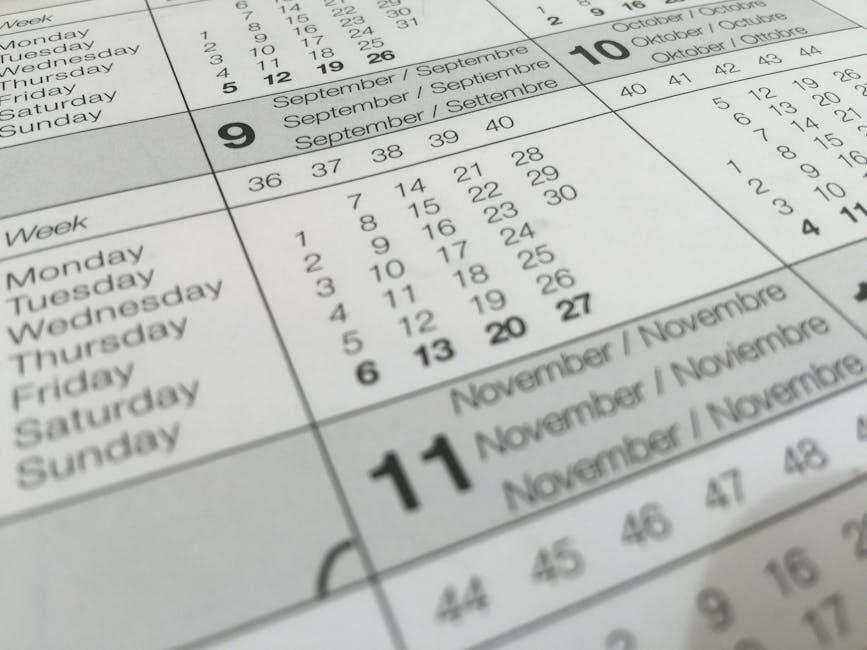Mastering the 12 English tenses is essential for clear communication. These tenses, divided into past, present, and future, help express actions and states accurately. Each tense has specific structures and uses, such as the simple present for routines or the present perfect for actions continuing to the present. Resources like PDF guides and exercises simplify learning, ensuring fluency in both spoken and written English.
Importance of Tenses in Communication
Understanding and correctly using the 12 English tenses is fundamental for effective communication. Tenses provide clarity about when actions occur, allowing speakers and writers to convey their intended meaning with precision. Without proper use of tenses, sentences can become ambiguous, leading to misunderstandings. For example, saying “I eat dinner” (simple present) differs from “I am eating dinner” (present continuous) or “I ate dinner” (simple past), each conveying different time frames and contexts.
In both spoken and written communication, tenses help establish the timeline of events. They enable listeners or readers to grasp the sequence of actions, making conversations and texts more coherent. For instance, in storytelling, tenses differentiate between what happened in the past, what is happening now, and what will happen in the future. This ability to express time relationships is essential for clear and engaging communication.
The importance of tenses extends beyond grammar; they are vital for professional and academic writing. In essays, reports, and formal documents, accurate tense usage ensures that ideas are presented logically and persuasively. For instance, historical events are typically written in the past simple tense, while ongoing research might use the present perfect continuous tense. This consistency enhances credibility and professionalism.
Moreover, mastering the 12 English tenses is crucial for language learners aiming to achieve fluency. Mistakes in tense usage can alter the meaning of sentences, potentially leading to confusion. For example, “I have eaten” (present perfect) implies completion, whereas “I am eating” (present continuous) suggests an ongoing action. Such distinctions are vital for conveying the intended message accurately.

The 12 English Tenses Explained
The 12 English tenses are divided into past, present, and future categories, each with four aspects: simple, continuous, perfect, and perfect continuous; This comprehensive system allows speakers to express actions and states with precision, ensuring clear communication. From daily routines to complex narratives, mastering these tenses enhances fluency and accuracy in both spoken and written English. Detailed guides and downloadable PDFs provide structured learning support.

Simple Present Tense: Structure, Usage, and Examples
The Simple Present Tense is one of the most commonly used tenses in English. It is used to describe habits, routines, facts, and general truths. The structure of the Simple Present Tense is straightforward: Subject + Base Verb. For most verbs, the base form is used, but for the third person singular (he, she, it), an ‘s’ or ‘es’ is added.
- Structure:
― Affirmative: Subject + base verb (e.g., I play, she plays).
⏤ Negative: Subject + do/does not + base verb (e.g., I do not play, she does not play).
― Question: Do/Does + subject + base verb? (e.g., Do you play?, Does she play?). - Usage:
⏤ Habits/Routines: To describe regular actions (e.g., I eat breakfast at 7:00 AM).
⏤ Facts/Truths: To state facts or universal truths (e.g., The sun rises in the east).
― Scheduled Events: To talk about timetabled events (e.g., The bus leaves at 8:00 PM). - Examples:
― I live in London.
― She works as a teacher.
― They play football every weekend.
― Do you study English every day?
⏤ He does not like coffee.
Exceptions include verbs that change spelling in the third person singular, such as “try – tries” or “go – goes.” The Simple Present Tense is a foundational tense, and mastering it is crucial for effective communication in English. Resources like PDF guides and practice exercises can help learners understand and use this tense confidently.
Present Continuous Tense: Structure, Usage, and Examples
The Present Continuous Tense is used to describe actions that are happening at the moment of speaking, or actions that are temporary and ongoing. It is formed using the auxiliary verb “am,” “is,” or “are” followed by the present participle of the main verb (the base verb + “-ing”).

- Structure:
― Affirmative: Subject + am/is/are + present participle (e.g., I am studying).
― Negative: Subject + am/is/are + not + present participle (e.g., I am not studying).
⏤ Question: Am/Is/Are + subject + present participle? (e.g., Are you studying?). - Usage:
⏤ Actions in Progress: To describe something happening now (e;g., She is cooking dinner).
⏤ Temporary Situations: To talk about actions that are not permanent (e.g., I am living with a friend until I find an apartment).
― Planned Future Events: To express arrangements or plans (e.g., We are meeting at 7 PM tomorrow). - Examples:
― I am reading a book right now.
― They are playing football in the park.
⏤ Are you watching TV?
⏤ He is not working today.
⏤ She is attending a conference next week.
Exceptions to the “-ing” rule include verbs like “make – making” or “take – taking,” where the spelling remains straightforward. However, some verbs like “die – dying” or “tie – tying” require a slight change in spelling. The Present Continuous Tense is particularly useful for emphasizing the ongoing nature of an action, making it a versatile tool in everyday communication.
Simple Past Tense: Structure, Usage, and Examples

The Simple Past Tense is used to describe actions or events that occurred and were completed in the past. It is one of the most commonly used tenses in English and is essential for storytelling and recounting experiences.

- Structure:
― Affirmative: Subject + past form of the verb (e.g., I walked).
⏤ Negative: Subject + did not + base form of the verb (e.g., I did not walk).
⏤ Question: Did + subject + base form of the verb? (e.g., Did you walk?). - Usage:
⏤ Completed Actions: To talk about actions that happened and finished in the past (e.g., She went to the store yesterday).
⏤ Sequential Events: To describe actions that occurred one after another (e.g., I woke up, ate breakfast, and left for work).
― Habits or Routines: To express regular past actions (e.g., I walked to school every day when I was a child).
⏤ Finished Time Periods: To refer to a specific time in the past that is now over (e.g., I lived in Paris for five years). - Examples:
⏤ He played football last weekend.
― They did not attend the meeting yesterday.
― Did she call you last night?
― We studied for the exam all day.
― The bus left at 8 PM.
Regular verbs form the past tense by adding “-ed” (e;g., walk → walked), while irregular verbs change their form completely (e.g., go → went). Mastery of the Simple Past Tense is crucial for effective communication, as it allows speakers to clearly convey past events and experiences.
Past Continuous Tense: Structure, Usage, and Examples
The Past Continuous Tense is used to describe actions that were ongoing or in progress at a specific time in the past. It often indicates that an action was interrupted by another event or was occurring simultaneously with another action.
- Structure:
⏤ Affirmative: Subject + was/were + present participle (e;g., I was walking).
⏤ Negative: Subject + was/were + not + present participle (e.g., I was not walking).
⏤ Question: Was/were + subject + present participle? (e.g., Were you walking?). - Usage:
⏤ Simultaneous Actions: To describe two or more actions happening at the same time in the past (e.g., She was cooking while he was cleaning).
⏤ Interrupted Actions: To show an action that was interrupted by another event (e.g., I was studying when the phone rang).
― Time as an Adverb: To emphasize the duration of an action (e.g., He was working all day). - Examples:
― They were traveling across Europe last summer.
⏤ I was not watching TV at 9 PM; I was reading a book.
⏤ Were you playing guitar at 7 PM yesterday?
⏤ The kids were playing outside when it started raining.⏤ She was preparing dinner while her sister was setting the table.
The Past Continuous Tense is particularly useful for creating vivid descriptions of past events, especially when detailing ongoing activities. It is often used in combination with the Simple Past Tense to show the relationship between actions (e.g., I was reading a book when she called). Mastering this tense helps in expressing complex sequences of events clearly and effectively.
Present Perfect Tense: Structure, Usage, and Examples
The Present Perfect Tense is used to connect past events with the present. It emphasizes the relationship between an action that occurred in the past and its relevance to the current moment. This tense is particularly useful for expressing experiences, completed actions, and ongoing actions that started in the past and continue to the present.
- Structure:
― Affirmative: Subject + have/has + past participle (e.g., I have completed the task).
― Negative: Subject + have/has + not + past participle (e.g., I have not completed the task).
⏤ Question: Have/has + subject + past participle? (e.g., Have you completed the task?). - Usage:
― Experiences: To talk about events that happened at an unspecified time in the past (e.g., I have visited Paris three times).
― Completed Actions: To describe actions that started and finished in the past but have a connection to the present (e.g., She has already eaten dinner).
― Ongoing Actions: To indicate actions that began in the past and continue to the present (e.g., They have lived here since 2010).
― Recent Actions: To emphasize the nearness of a past event (e.g., I have just finished the report). - Examples:
― I have read this book before.
― Have you ever been to Japan?
⏤ She has not seen that movie yet.
― We have been friends since childhood.
― He has already left for the airport.

Key points to remember include using “just,” “already,” “yet,” and “ever” with the Present Perfect Tense to add context. For example, “I have just finished my homework” highlights a recent completion, while “Have you ever traveled abroad?” asks about an experience at any point in the past. This tense is versatile and essential for expressing complex time relationships in English.
Present Perfect Continuous Tense: Structure, Usage, and Examples
The Present Perfect Continuous Tense is used to describe actions that began in the past and are still ongoing at the time of speaking. It emphasizes the duration of the action rather than its completion. This tense is particularly useful for highlighting the progress or continuity of an action over time.
- Structure:
― Affirmative: Subject + have/has + been + present participle (e.g., I have been working on this project).
⏤ Negative: Subject + have/has + not + been + present participle (e.g., I have not been feeling well).
⏤ Question: Have/has + subject + been + present participle? (e.g., Have you been studying all night?). - Usage:
― Duration of Actions: To indicate how long an action has been happening (e;g., We have been waiting for the bus for 30 minutes).
― Recent Ongoing Actions: To emphasize that an action started in the past and continues to the present (e.g., She has been living in this city since last year).
― Repeated Actions: To describe actions that have been repeated over a period of time (e.g., He has been visiting his grandparents every weekend).
⏤ Temporary Situations: To talk about situations that are temporary and ongoing (e.g., I have been staying with a friend while my apartment is being repaired). - Examples:
⏤ I have been reading this book all morning.
⏤ Have they been practicing the piano regularly?
⏤ She has not been attending classes lately.
⏤ We have been traveling around Europe for three months.
― He has been working non-stop since yesterday.

Key points to remember include using time expressions like “since,” “for,” and “how long” with this tense. For example, “I have been studying English since 2020” emphasizes the duration of the action. Additionally, this tense is often used with verbs that describe ongoing or repeated activities, rather than one-time events. Mastering the Present Perfect Continuous Tense helps in expressing actions that are still in progress, providing clarity and precision in communication.



